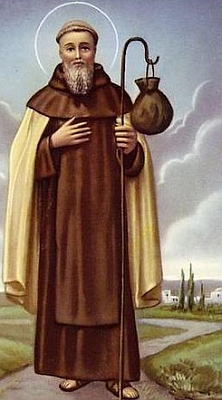
OCTOBER 21 is the traditional feast day of ST. HILARION (+c. 371). Hilarian is cited as the founder of Palestinian monasticism. Information about St. Hilarion primarily comes from St. Jerome, who wrote a biography of the anchorite in 390, only a few years after Hilarion’s death. The biography seemed to be exaggerated, showing the characteristics of heros in the 4th century. Some of the stories may be fantasized but some of them are fact. What seems true is here.
Hilarion was born in Thabatha, south of Gaza, in Syrian Palestrina. His parents were pagan. He had siblings. At a young age, Hilarion was sent to Alexandria to study rhetoric with a grammarian. Barely a teenager, Hilarion was a delicate youth of fragile health. While there, the young boy converted to Christianity, throwing off his entertainments and spending his extra time in church. By fifteen, Hilarion was ready to live with the famous anchorite, St. Anthony the Great, who lived in the Egyptian desert. The young man found the hermitage crowded with visitors seeking cures for everything from diseases to demonic afflictions.
Hilarion lasted only two months. He went home, accompanied by a few of St. Anthony’s monks. There he found out that his parents had died during his absence. He took his inheritance and divided it up among his brothers and the poor of the town. Then he left.
Still very young, Hilarion chose to go into the desert of Syrian Palestrina, a most dangerous area. It was known to be inhabited by robbers and other people of bad nature. He lead a nomadic life, praying, fasting and making baskets to sell for necessities.
After a while, he moved to what is now Deis al-Balah in Gaza. He built a hut of reeds and grasses, giving himself extreme penances. For four years he lived there before building himself a smaller cell. He sang hymns and recited the Bible most of the day. He was looked on as a very wise, devout man. Men and women began coming to him as a spiritual leader, staying in the area. A monastery began to be built around him.
This was not the life he wanted. He moved away. They followed. He tried to get away by going back to St. Anthony. But his fame preceded him. One of the reasons he was so well known was his miracles. He cured and saved people from death. Knowledge became so wide-spread that crowds appeared wherever he went.
He moved across North Africa, settled briefly in Sicily, then moved to Dalmatia and on to Cyprus, where he died in 371. His body was brought back to Syria Palestrina where he was buried near the monastery.
“And now there remain faith, hope, charity, these three: but the greatest of these is charity.”–1 Cor xiii. 13


Recent Comments